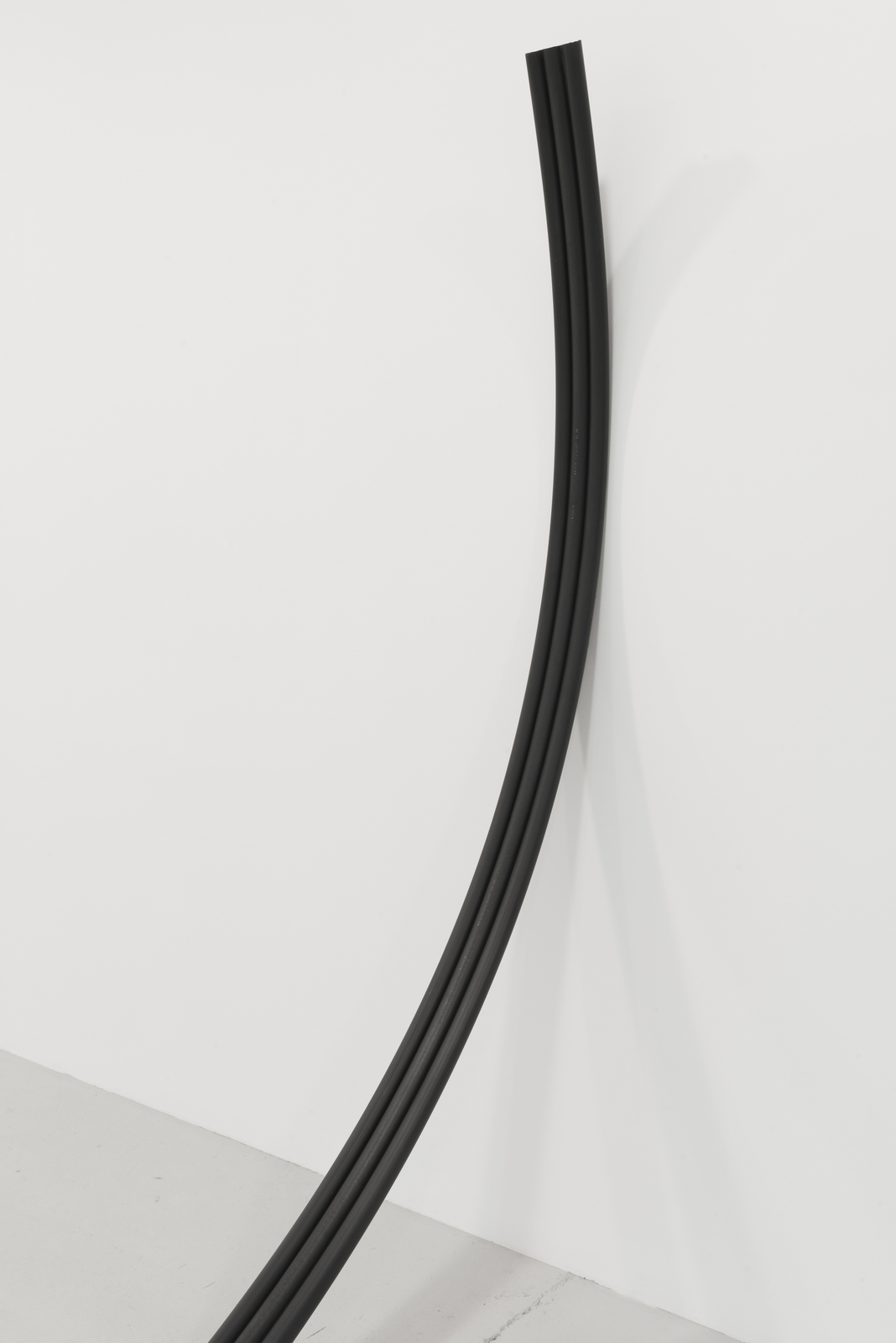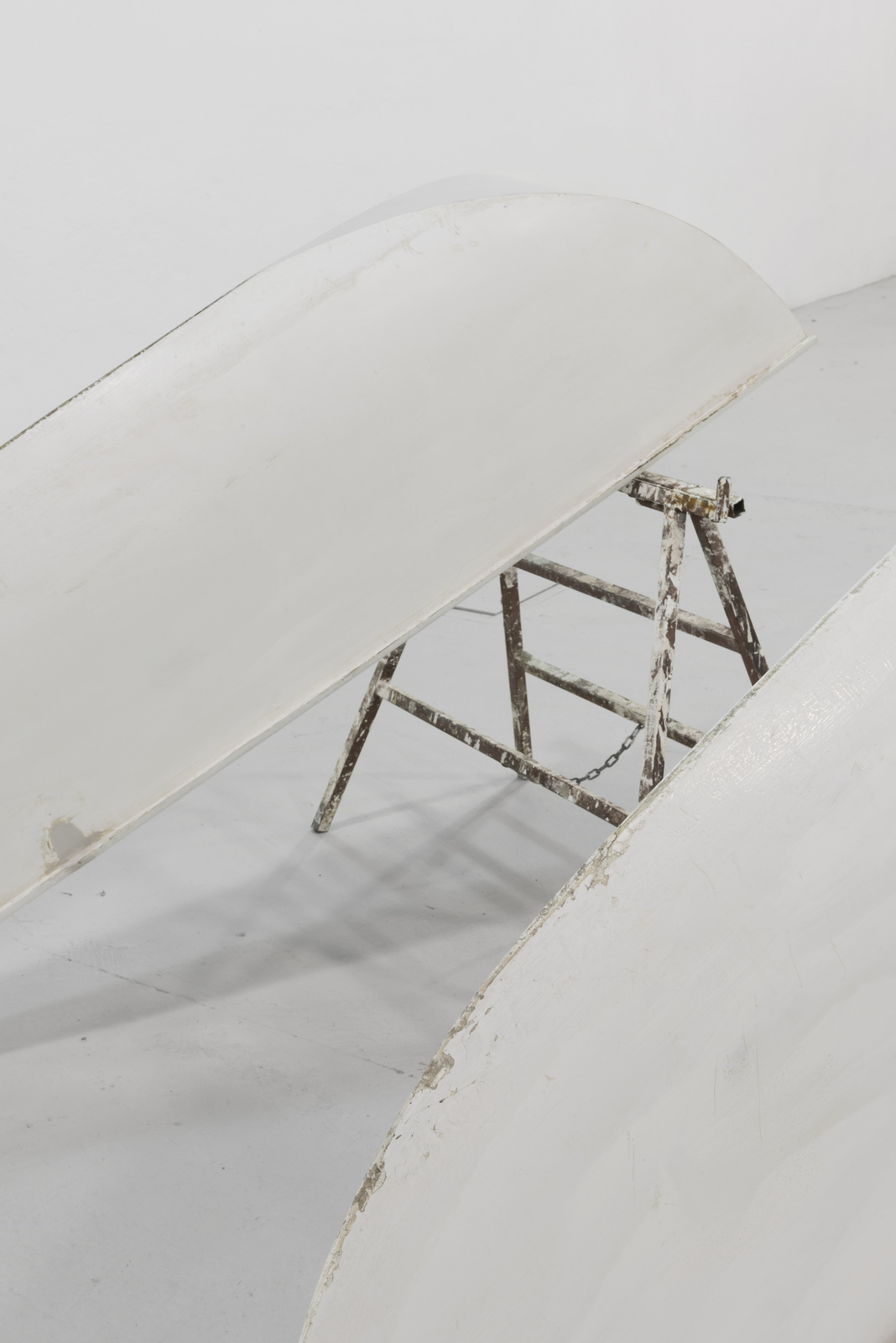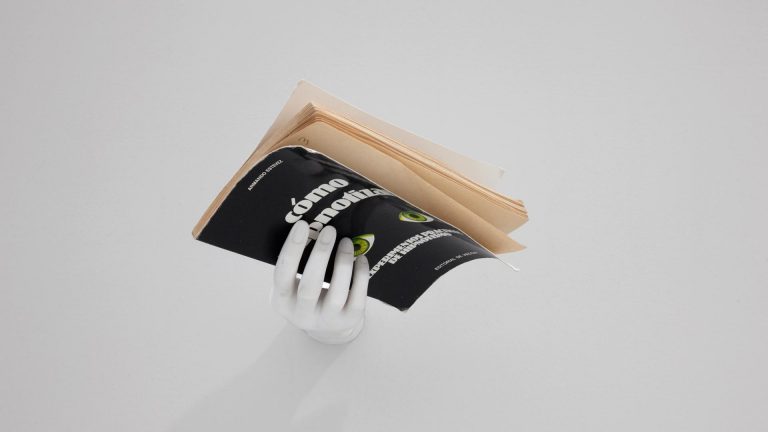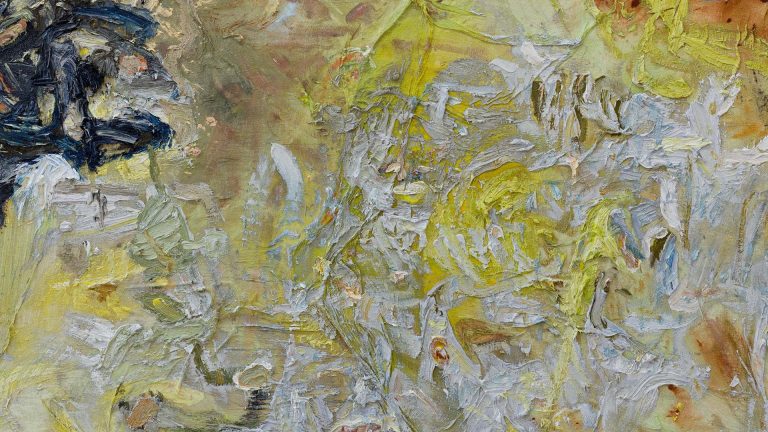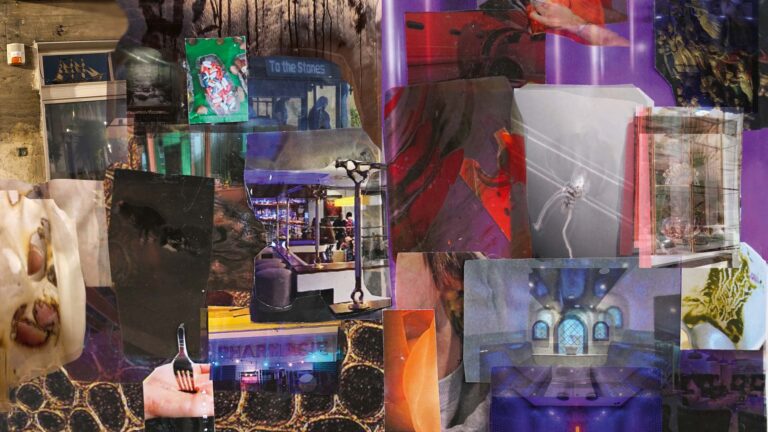Artist: Alejandro Leonhardt
Exhibition title: 341 PASOS
Venue: L21 Gallery, Mallorca, Spain
Date: March 20 – June 2, 2017
Photography: Roberto Ruiz, all images copyright and courtesy of the artist and L21 Gallery, Mallorca
We never finish anything[1]
“The plot of land isn’t being used for productive purposes at the moment, other than generating vegetation. We could speak of more than a thousand cables of varying weight, that unwrap themselves to various rhythms and intensities. A characteristic only attributable to the wind. They are the plot’s visible face: its owners. Such a precedent doesn’t subtract from the fact that the terrain has been delimited, or rather, fenced in, by trash. The latter, a reductionist term to refer to the infinite. In plain sight, the trash seems more varied than the vegetation, although it has a more fatigued and depressed look, in some cases, haggard and rank. This doesn’t exclude that both the vegetation and the trash are participants of gravity, which treats us all as equal, and they rest on the ground alongside the weight of the dust that has endured the very same dust.” This is how Alejandro Leonhardt describes the lot that, in a period of two months, has been transformed in his hunting grounds first and in his workshop second. This lot is 341 steps away from the gallery that now accommodates his exhibit.
Trash is a mass whose content no longer has proper nouns. A heterogeneous and random accumulation of objects that have lost the names they used to have and are no longer possible to separate from one another. And this is because “in the trash everything gets lost, made from discarded remains, like what one sweeps in their home and in the streets or what ferments in dumps until it constitutes a confusing mass. What has no name can only be trash, and before that, it must lose its name”[2].
How to differentiate once more the objects that hide within the trash? How to go to the rescue of what’s been discarded, of something without a name nor value? Maybe through a view that continually moves and allows itself to be razed by a whirlwind of patterns and their meanings. Or maybe through a series of slow operations to which it seemed to be excluded.
Alejandro Leonhardt proceeds by detaining on the waste and, with intense care, tries to rename what has lost its name forever. His method is to turn his back on the tale of the victors to pay attention to the tradition of the oppressed, the nobodies, the homeless, the undocumented and so many others that I ignore…[3].
Where his journeys have taken him, there is silent vegetation which sprouts, following the rhythm of the seasons. Describing this place, the artist mentions “it could’ve been a shop, a factory, a cellar. I don’t know, and the people I’ve asked don’t know either. The plot has been abandoned for over 20 years, they say. Now it’s a terrain on sale with a big green sign, with white capital letters that say: EN VENTA SOL- (PLOT FOR SALE). The letters A and R are covered by another sign, of red and white colors, from a real estate company with the slogan: Where your future lives”.
Leonhardt focuses on a place where only oblivion seemed to live, covered by vegetation and trash. In his associations he resorts to an affective sensibility to pamper what has no name nor value and, work with it. The effort of his practice is centered in rediscovering and amplifying the potentiality of the materials, both plastically and conceptually. His interventions about what’s discarded consists in displacements, from pure indefiniteness to a condition of exceptional ‘objects’. Successively, he gathers them in the exhibition space as a result of abstraction essays. One must understand said abstraction as a form of resistance; it will never be possible to take advantage of them for their function or utility. An infinite potentiality must not be reduced in pursuit of a productive future. These pieces only allow others to look at and interrogate them. They are enjoyed via a non-capitalized experience, whose value is impossible to set. Because it’s about a “piece always at work”[4], continually changing, rehearsing and proposing processes that pretend to reach the core of the matter. But, what is the core of this exhibit?
The names of the pieces of 341 Pasos (341 Steps) avoid defining the object that comprises them. They are fictions that add a certain literary tension to the sculptures. At most, they work as signals on a trail with many branches. Quebrar su voluntad, para que se someta a tu voluntad (Break its will, so it submits to your will) consists of two metal trestles that hold the pieces of an abandoned boat that’s been intervened by the artist. Leonhardt has cut and molded the structure, transformed its forms. Now these draw near, as much as they recede, from the original boat. The surface has been polished and, by successive subtractions, has been transformed into something aerodynamic that seems to rest while waiting to lift off once more.
In La comodidad de ser algo que no eres (The comfort of being something you are not) we see three long pipes that have been forced to defy gravity and in doing so swing gently in the space. We abandon the original function of the pipes to allow other questions, like balance and gravity, to flourish. A white window coupled with a green raincoat draws a flat volume in the space, hieratic and mute. The window is held by a hook that anchors it to the ground, while the raincoat manages to protect the intimacy of the grid. Its title, Lo necesario puede ser tan arbitrario como caprichos tengamos (Necessity can be as arbitrary as the whims we have), accentuates the will to constantly rename. These objects suggest -without completely defining it- new formal and logical devices, while their presence in the gallery evokes indeterminate possibilities.
There are no traits of improvisation or chance in this project; its fruit of a methodical logic that manages to stage an unstable situation. A subtle structure holds on the wall several old tiles. They form a pictorial composition with the remains of the binder that was previously used to adhere them to a wall. What our sight discovers there is as unappreciable as its title: Acercamientos emocionales hacia preguntas dadas por las circunstancia y la gravedad (Emotional approaches to questions given by circumstance and gravity).
His fictions take us to places where time stops and everything is excessive. He works with day to day situations using an affectionate methodology. His proceeding is concrete and necessary to unfold an infinite spectrum of unexpected possibilities. His slow operations are the fruit of an inexhaustible process, where both the affective and conceptual care open a breach in the ultra-fast times of consumerism. This project proposes to decelerate and continually rename what’s in our reach; it imposes a pause to give way to an emotional elaboration.
Beyond a plastic component of indubitable evocative strength, to walk this exhibition is to physically relate with fundamental questions like the material, weight, volume and surface. Successively, concepts like the construction of value, the act of naming without defining and the resistance against reification emerge. Leonhardt chooses to focus on what has no name; he conforms to suggesting possibilities, maybe more paused and demanding, of affection.
341 Steps reunites a set of surviving and unending pieces; they are the achieved result of a slow affective attention. They are unproductive because they continually subtract and move the value of the used materials without fixing it or determining it; they are the result of work understood as a perpetual rehearsal and continuous attention -which is not eventual stimulation. It is about modest proposals in their origin and valiant in accommodating a spectator that doesn’t require a direct response, but who keeps searching. Which isn’t insignificant.
-Francesco Giaveri
[1] Man Ray, quoted in Georges Didi-Huberman, En la cuerda floja, Shangrila, Santander, 2015, p. 16
[2] Ángel González García, El resto, Museo de Bellas Artes de Bilbao y MNCARS, 2000, p. 295
[3] Walter Benjamin, quoted Georges Didi-Huberman, op. cit., p. 20
[4] “es preciso pensar el valor de lo imposible de fijar, de la experiencia capitalizada, de la obra siempre en obra”, Georges Didi-Huberman, op. cit., p. 17
Alejandro Leonhardt, 341 PASOS, 2017, installation view, L21 Gallery
Alejandro Leonhardt, 341 PASOS, 2017, installation view, L21 Gallery
Alejandro Leonhardt, 341 PASOS, 2017, installation view, L21 Gallery
Alejandro Leonhardt, Emotional Approaches To Questions Given By Circumstance And Gravity, 2017, Entire and fragmented floor tiles, 154 x 132 x 4 cm
Alejandro Leonhardt, Emotional Approaches To Questions Given By Circumstance And Gravity, 2017, Entire and fragmented floor tiles, 154 x 132 x 4 cm
Alejandro Leonhardt, 341 PASOS, 2017, installation view, L21 Gallery
Alejandro Leonhardt, 341 PASOS, 2017, installation view, L21 Gallery
Alejandro Leonhardt, The Comfort Of Being Something You Are Not, 2017, Three P.V.C united and bended pipes, 260 x 377 x 50 cm
Alejandro Leonhardt, The Comfort Of Being Something You Are Not, 2017, Three P.V.C united and bended pipes, 260 x 377 x 50 cm
Alejandro Leonhardt, The Comfort Of Being Something You Are Not, 2017, Three P.V.C united and bended pipes, 260 x 377 x 50 cm
Alejandro Leonhardt, 341 PASOS, 2017, installation view, L21 Gallery
Alejandro Leonhardt, Break Its Will, So It Submits To Your Will, 2017, Molded rowboat with fiberglass and filler on iron easels, Variable dimensions
Alejandro Leonhardt, Break Its Will, So It Submits To Your Will, 2017, Molded rowboat with fiberglass and filler on iron easels, Variable dimensions
Alejandro Leonhardt, Break Its Will, So It Submits To Your Will, 2017, Molded rowboat with fiberglass and filler on iron easels, Variable dimensions
Alejandro Leonhardt, 341 PASOS, 2017, installation view, L21 Gallery
Alejandro Leonhardt, Necessity Can Be As Arbitrary As The Whims We Have, 2017, Raincoat on window, 164 x 132 x 20 cm
Alejandro Leonhardt, Necessity Can Be As Arbitrary As The Whims We Have, 2017, Raincoat on window, 164 x 132 x 20 cm
Alejandro Leonhardt, 341 PASOS, 2017, installation view, L21 Gallery











